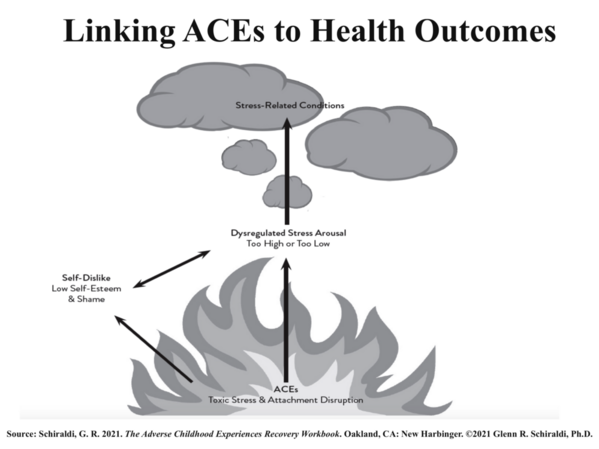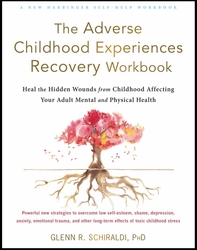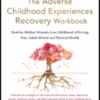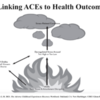Glenn R. Schiraldi, Ph.D. Psychology Today blog post, June 27, 2022
On the outside, Selena and Brandon are personable, charming, and “successful.” Inside, they are deeply dissatisfied with themselves, and can’t be reasoned out of their inner sense of worthlessness. Nothing on the surface accounts for their self-loathing and shame—but their childhood experiences do!
Toxic shame imprinted in childhood causes untold emotional and physical suffering in adulthood. Toxic shame is common and understandable in those who have experienced adverse childhood experiences (ACEs). Fortunately, being stuck in painful shame need not be a life sentence.
Let’s assume you have learned and applied the foundational skills for healing the inner wounds from the first eighteen years of fife. These skills involve:
- Regulating dysregulated stress arousal and the strong emotions that maintain this arousal
- Strengthening and stabilizing the nervous system through imagery practices that simulate healthy attachment and coping experiences
- Optimizing brain health and functioning
- Rewiring old disturbing events compassionately
How do you now dislodge the remnants of lingering shame?
About Shame
Shame is feeling bad to the core, feeling bad about who you are. It is experiencing the self as damaged, defective, inadequate, worthless, unlovable, or disgusting. It amounts to self-dislike, low self-esteem, self-loathing, or self-contempt. Shame is emotionally painful. It also exacerbates and maintains the dysregulated stress caused by ACEs that causes so much physical damage in adulthood.
Shame can be imprinted implicitly in the earliest months or years of childhood and lodges mostly in the right brain, with its strong connections to the emotional and survival centers of the brain. Recall that the non-verbal, visual right brain is “on line” (that is, sufficiently developed to process and store memories) in the first three years of life. So disturbing early childhood memories are processed by the right brain and stored non-verbally, beneath conscious awareness—as images, feelings, bodily sensations, and survival tendencies (such as tightening muscles when anxious in preparation to flee).
The left brain, which stores and consciously recalls memories with words and logic, does not usually come on line until the third year of life. Prior to this time, the right brain is storing shameful memories beneath conscious awareness as an enduring felt sense—a sense of dread or wrongness that plays out as visceral sensations, emotions, and images (with their accompanying external senses, like sound), rather than words and logic. Because early childhood memories play out in the non-verbal right brain beneath conscious awareness, it is usually difficult to talk or reason someone out of shame imprinted in early childhood. For example, the infant internalizes a caregiver’s angry or disgusted facial expression or tone of voice, without understanding the spoken words. The memory is deeply imprinted as shame. In adulthood, the shame is not usually responsive to talking and logic, at least initially.
Even after the third year, when the left-brain is on line, overwhelming shaming experiences again often lodge primarily in the right brain because the left brain shuts down during overwhelming stress. (When intensely threatened, the pressing need is to fight, flee, or freeze to survive—not speak or reason). Recent shaming experiences can not only layer on top of early childhood imprints of shame, but can also trigger painful shame reactions from the first three years of life. Perhaps criticism or rejection in adulthood from someone who is important now elicits extreme emotional pain. And the person wonders, “Why am I reacting so strongly to this? Why can’t I have a tougher skin? Why can’t I be more resilient?” Shame lurking beneath the surface gives an important clue.
So talk therapy is not usually the best starting place for healing shame that is imprinted in childhood. Rather than starting with treatments that emphasize talking and logic, it is usually more effective to rewire shaming memories with approaches that emphasize images, emotions, and bodily sensations.
Shame Awareness
Is shame interfering with your life? Adults are often unaware of the depths to which unresolved shame from childhood is “running their show,” since it often plays out beneath conscious awareness. Awareness, then, is the first step in rewiring shame. Without judging, but with compassion and curious interest, notice if you experience any of shame’s many symptoms:
- Being highly sensitive to criticism
- Doubting yourself
- Being harshly self-critical
- Experiencing anxiety or depression
- Stooped posture (or sometimes rigid, aggressive posture)
- A feeling of heaviness
- Knotted gut; dry throat; tightness in the throat, chest, or muscles
- Feeling tense or uncomfortable around others; feeling the impulse to run or hide
- Nervous laughter; excessive need to please others
- High stress arousal (e.g., pounding heart, rapid breathing, sleep problems)
- Low stress arousal (e.g., feeling emotionally numb, flat, dead inside, exhausted, or collapsed)
- Lack of everyday joy or feeling at ease
- Self-loathing, self-contempt, low self-esteem, self-dislike
- Disgust with oneself or one’s body
- Feeling inadequate, unlovable, bad, different, like you don’t fit in
- Insecure, worried about others’ judgments
- Seeking love and attention in unhealthy ways
- Keeping secrets; afraid to let people, even friends, in
- Difficulty loving and accepting yourself
- Putting up a false front to impress people (e.g., perfectionist or super-achiever)
- Attempting to numb inner pain (e.g., addictions, forgetting painful memories, self-harm)
- Afraid of the pain of failing; quit trying
- Trying to become invisible so as to avoid negative judgments of others
- Negativity (sarcasm, blaming, or aggression toward others to keep the focus away from self)
- Lack of self-care
- Thinking about suicide or using drugs or other addictions to escape the pain
Maybe you have learned how to hide shame through achievements or a winning personality, yet inside the pain of shame persists.
The ACEs & Shame Model
This graphic depicts the relationship between ACEs, dysregulated stress arousal, shame, and the consequences of unresolved ACEs.
ACEs, including attachment disruptions, lead to dysregulated stress arousal (arousal that is stuck on too high or too low). Dysregulated stress arousal is central to the stress-related conditions that ACEs predict, including depression, anxiety, PTSD, and a host of medical and functional problems.
ACEs often imprint shame (low self-esteem, self-dislike), which can cause, exacerbate, and maintain dysregulated stress, while inability to manage dysregulated stress can cause a sense of shame.
The Healing Principles
Shame attacks the basic needs of each person to feel
- Worthwhile—literally, worth the while, worth the time to live fruitfully and with joy
- Lovable
- Capable of navigating life reasonably well and growing
However, shame does not reflect one’s true core worth. One’s infinitely worthwhile core survives and is capable of healing (heal has the same root as health and whole). Healing involves rewiring shame pathways in the brain and feeling whole again.
Shame can be viewed as a signal to love and accept the imperfect, but worthwhile core self. Love is the healing agent and strong countermeasure to shame’s painful wiring. Love stimulates the release of oxytocin, which reduces cortisol and stress. Love also neutralizes shame and overwrites shame circuitry in the brain with self-liking and acceptance.
Summary
Shame from the early years is normal and understandable, but need not persist for decades unchallenged. Shame can be softened and its painful grip lessened. The next blog will explore how the shame from ACEs is rewired and transformed.
Reference
Schiraldi, G. R. (2021). The Adverse Childhood Experiences Recovery Workbook. Oakland, CA: New Harbinger.
About the Author
Glenn R. Schiraldi, PhD, has served on the stress management faculties at The Pentagon, the International Critical Incident Stress Foundation, and the University of Maryland, where he received the Outstanding Teacher Award in addition to other teaching/service awards. His fourteen books on stress-related topics have been translated into seventeen languages, and include The Adverse Childhood Experiences Recovery Workbook, The Self-Esteem Workbook. The Resilience Workbook, and The Post-Traumatic Stress Disorder Sourcebook. The founder of Resilience Training International (www.ResilienceFirst.com), he has trained laypersons, emergency responders, and clinicians around the world on the diverse aspects of stress, trauma, and resilience.




Comments (0)